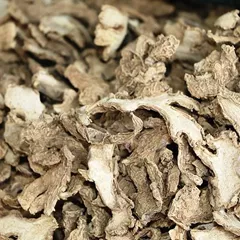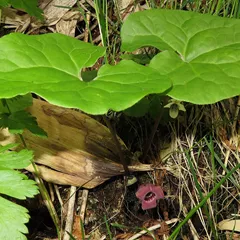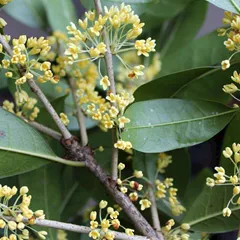Phlegm-Fluids above the diaphragm
The information provided here is not a replacement for a doctor. You shouldn't use it for the purpose of self-diagnosing or self-medicating but rather so you can have a more informed discussion with a professional TCM practitioner.
At a glance
Preliminary reading: What is a pattern? The concept of Phlegm The concept of Fluids
Key attributes
Chinese name: 支饮 Pinyin name: Zhī Yǐn
Pattern nature: Full
Pattern hierarchy: Specific pattern under Phlegm-Fluids
Causes
Precursor patterns: Phlegm-Fluids in the Lungs
Common causes: External Cold
Diagnosis
Common symptoms: Asthma Oedema Coughing Dizziness Profuse white sputum and one other symptoms
Pulse type(s): Wiry (Xian)
Tongue description: Swollen tongue with thick sticky white coating
Treatment
Treatment principle: Warm the Empty Cold of the Lungs, tonify the Spleen and Kidney Yang, remove Dampness, Phlegm and Fluids
Common formulas: Xiao Qing Long Tang Ling Gan Wu Wei Jiang Xin Tang
Pathology
When Lung Qi is stagnant or Deficient (because, for instance, of Wind-Cold), Phlegm-Fluids (a type of Phlegm characterized by white, very watery and thin sputum) accumulates in the Lungs because they cannot fulfill their function of sending the Fluids down to the Kidneys or to the skin and muscles. See our chapter on the formation of Body Fluids for an explanation of this process.
This leads to symptoms such as coughing and wheezing (with copious, white, watery sputum), a stifling sensation in the chest, and, in very severe cases, difficulty in breathing while lying down. The symptoms of absence of thirst and the moist tongue coating indicate a overabundance of Fluids in the body. All the symptoms tend to be aggravated by exposure to Cold.
Causes
Precursor patterns: Phlegm-Fluids above the diaphragm can derive from Phlegm-Fluids in the Lungs
External Cold: Prolonged exposure to external cold environment can cause this pattern.
Diagnosing Phlegm-Fluids above the diaphragm
Diagnosing a pattern in Chinese Medicine is no easy feat and should be left to professional practitioners. In particular one has to know how to differentiate between different types of pulses and tongue coatings, shapes and colors as well as learn to read from a long list of seemingly unrelated symptoms.
Pulse type(s): Wiry (Xian)
Tongue description: Swollen tongue with thick sticky white coating
Main symptoms: Asthma Oedema Coughing Dizziness Profuse white sputum Feeling of oppression of the chest
Diagnosis commentary: Key characteristic symptoms of this pattern are the chest fullness and coughing which get worse when lying down.
Treating Phlegm-Fluids above the diaphragm
Treatment principle
Warm the Empty Cold of the Lungs, tonify the Spleen and Kidney Yang, remove Dampness, Phlegm and Fluids
Herbal formulas used to treat Phlegm-Fluids above the diaphragm



The top herbs in Ling Gan Wu Wei Jiang Xin Tang are Dried Ginger (Gan Jiang), Wild Ginger (Xi Xin) and Poria-Cocos Mushrooms (Fu Ling)
Ling Gan Wu Wei Jiang Xin Tang
Source date: 220 AD
Number of ingredients: 5 herbs
Key actions: Warms the Lungs. Transforms congested Fluids.
Formula summary
Ling Gan Wu Wei Jiang Xin Tang is a 5-ingredient Chinese Medicine formula. Invented in 220 AD, it belongs to the category of formulas that warm and transform Phlegm-Cold.
Besides Phlegm-Fluids above the diaphragm, Ling Gan Wu Wei Jiang Xin Tang is also used to treat Cold-Phlegm in the Lungs or Phlegm-Fluids in the Lungs.



The top herbs in Xiao Qing Long Tang are Ephedra (Ma Huang), Cinnamon Twigs (Gui Zhi) and Dried Ginger (Gan Jiang)
Xiao Qing Long Tang
Source date: 220 AD
Number of ingredients: 8 herbs
Key actions: Releases the Exterior. Transforms Phlegm-Fluids. Warms the Lungs. Directs Rebellious Qi downward.
Formula summary
Xiao Qing Long Tang is a 8-ingredient Chinese Medicine formula. Invented in 220 AD, it belongs to the category of formulas that clear Wind-Cold.
Besides Phlegm-Fluids above the diaphragm, Xiao Qing Long Tang is also used to treat Wind-Cold-Water invading the Lungs or Phlegm-Fluids in the limbs.
Related conditions
Please keep in mind that a Western Medicine condition can be caused by several Chinese Medicine patterns of disharmony and vice versa. As such a patient suffering from one of the conditions below will not necessarily be suffering from Phlegm-Fluids above the diaphragm, it is just one pattern that's commonly associated with the condition. Click on a condition to learn what other patterns it's associated with.
Peptic ulcers Cirrhosis Epilepsy Conjunctivitis Bacillary dysentery Bronchitis Emphysema Upper respiratory tract infections Rheumatic heart disease Periarthritis of the shoulder Cardiopulmonary disease Enuresis Bronchial asthma Allergic rhinitis Nephritis Hay fever Dacryosolenitis Enteritis Atrophic gastritis Pleuritis
Consequence patterns
Kidney Yang Deficiency with Water overflowing
Lung Qi Deficiency over a long period of time with an accumulation of Phlegm-Fluids in the Lungs may lead to Kidney Yang Deficiency with Water overflowing.
